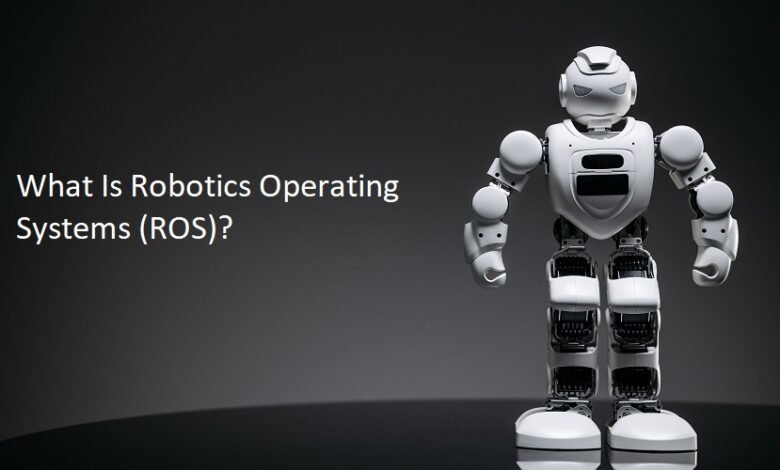What is Robotics Operating System (ROS)?

The Robotics Operating System (ROS), a ground-breaking innovation, has become well-recognized in robotics. Engineers and researchers may effectively construct and control robots with the open-source ROS framework, which offers a selection of software libraries and tools. It is an operating system for robots that enables them to perform challenging jobs efficiently.
The Role of ROS in Robotics
Robotics Operating System plays a vital role in robotics by providing a structured framework for developing robot software. It is a middleware that makes it easier for robot parts like sensors, actuators, and control systems to communicate. With ROS, developers don’t have to think about low-level hardware interactions and can concentrate on designing higher-level functionality.
Key Features of ROS
Robotics Operating System offers several key features that make it a preferred choice among robotics enthusiasts and professionals.
Message Passing: Robotics Operating System utilizes a publish-subscribe model, where different robot components can publish and subscribe to messages. This asynchronous communication mechanism allows efficient data sharing between other parts of a robot system.
Package Management: Robotics Operating System provides a system that simplifies sharing and reusing code. Developers can create and distribute packages encapsulating specific robot functionalities, making collaborating and building upon existing work easier.
Hardware Abstraction: Robotics Operating System abstracts the underlying hardware, allowing developers to write robot software without worrying about specific hardware details. This abstraction layer enables portability and flexibility, making deploying software on various robot platforms easier.
Visualization Tools: Robotics Operating System includes visualization tools that help developers analyze and debug their robot systems. These tools provide graphical representations of sensor data, robot models, and simulated environments, aiding in the development and testing process.
Distributed Computing: Robotics Operating System supports distributed computing, enabling the distribution of computation across multiple machines or nodes. This feature is handy for complex robot systems that require extensive computational power.
Advantages of Using ROS
The utilization of Robotics Operating System offers numerous advantages for robotics development:
Modular and Scalable Architecture: ROS follows a modular and scalable architecture, allowing developers to break down complex tasks into smaller components. This modular approach enhances code reusability, maintainability, and overall system scalability.
Wide Community Support: ROS has a vibrant and active community of developers, researchers, and enthusiasts. This large community makes it simpler for newbies to get started and experienced users to cooperate by offering help, documentation, and a wealth of open-source products.
Open-Source Characteristics: Since ROS is an open-source framework, anyone can use, modify, and share it. Its openness promotes creativity and teamwork and hastens the creation of new robot applications.
Integration with Various Robots: ROS is designed to be compatible with many robots and robotic systems. It provides standardized interfaces and communication protocols, allowing seamless integration with different robot platforms. This flexibility enables developers to leverage the power of ROS across various robotic applications.
Applications of ROS
ROS finds applications in diverse fields, revolutionizing the way robots are used in different industries:
Industrial Automation: Robots can now handle activities like assembly, material handling, and quality control because of the widespread use of ROS in this industry. The modular design of ROS makes it easier to create adaptable and flexible robotic systems that are simple to integrate into running production lines.
Service Robots: ROS plays a crucial role in developing service robots to assist humans in various tasks. These robots can be deployed in healthcare, hospitality, and domestic settings, providing patient care, housekeeping, and entertainment services. ROS’s extensive library of packages and tools simplifies the development of service robots with advanced capabilities.
Autonomous Vehicles: ROS is widely employed in autonomous vehicles, including self-driving cars and drones. ROS enables the integrating of sensor data, perception algorithms, and control systems, allowing vehicles to navigate and interact with their environment autonomously. ROS’s scalability and distributed computing capabilities make it suitable for managing the complex computational requirements of autonomous systems.
Challenges and Limitations of ROS
While ROS offers numerous benefits, it also presents some challenges and limitations:
Complexity: ROS has a steep learning curve, requiring users to understand its architecture, concepts, and tools. Novice users may face challenges setting up and configuring the system and understanding the intricacies of message passing and node communication.
Real-Time Constraints: ROS was primarily designed for research and prototyping rather than real-time applications. This limitation makes it less suitable for time-critical tasks that demand precise timing and low-latency communication.
Resource Intensive: ROS consumes significant computational resources, which may limit its deployment on resource-constrained platforms. The distributed nature of ROS also introduces additional overhead, requiring careful consideration of system performance.
Future Trends and Developments
Several trends and breakthroughs can be anticipated in the upcoming years as the area of robotics and ROS continues to develop quickly:
Increased Real-Time Capabilities: ROS’ real-time capabilities are being improved to make it more suited for safety-critical applications like robotic surgery and driverless vehicles.
Integration with AI and Machine Learning: ROS will probably integrate more with AI and machine learning tools. Robots will be able to learn from and adjust to their surroundings thanks to this integration, increasing their autonomy and decision-making capacities.
Interoperability and standardization: The robotics Technology is attempting to standardize interfaces and protocols to increase interoperability across robotic systems. This standardization will hasten the creation of new robot applications, facilitate code sharing, and encourage collaboration.
Conclusion
Robotics Operating System (ROS) is a robust framework that revolutionizes the development and control of robots. It provides a structured environment for building robot software, with features such as message passing, package management, hardware abstraction, and visualization tools. ROS offers advantages such as modular architecture, broad community support, and open-source nature. It finds applications in industrial automation, service robots, and autonomous vehicles. While ROS has challenges and limitations, ongoing developments aim to address them and pave the way for a future where robotics plays a significant role in various domains.








